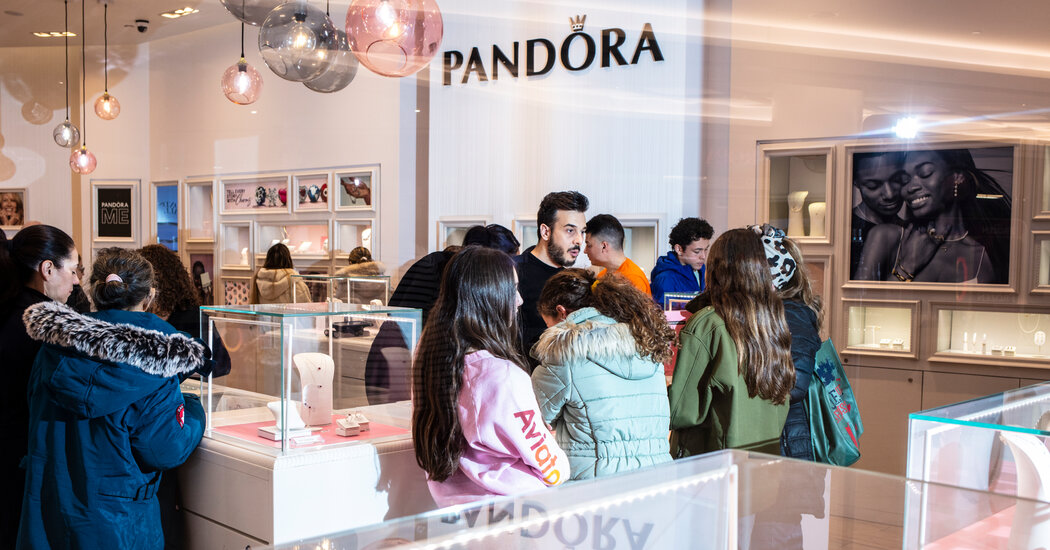Pandora, the world’s largest jewelry company, is based in Denmark and has nearly 500 stores in the United States, more than any of its other key markets. But in some ways, its real home is Thailand, where the company has been making its products for nearly four decades.
Like many global corporations, Pandora’s continent-crossing supply chain has allowed it to sell its goods worldwide at a low cost. But last month, that supply chain became a grave weakness when President Trump said he would impose 36 percent tariffs on goods entering the United States from Thailand, alongside steep tariffs on dozens of other countries.
After Mr. Trump unveiled his “reciprocal tariffs,” Pandora’s shares were among the worst performing in Europe. A week later, Mr. Trump postponed those tariffs until early July, offering a reprieve.
But the threat looms, and Alexander Lacik, the chief executive of Pandora, is not expecting the uncertainty that is paralyzing businesses to end. Unless tariffs return to previous levels, the next year will be turbulent, he said in an interview. For now, he added, there is little to do but wait to see how investors, customers and competitors react.
“With the information at hand today, I would be crazy to make big strategic decisions,” Mr. Lacik said.
Alongside business leaders all over the world, Mr. Lacik is grappling with how to respond to Mr. Trump’s unpredictable policies, which have generated almost maddening uncertainty. The Trump administration has started to show a willingness to lower tariffs, but his first agreements, with Britain and China, have posed more questions than answers, and tariffs are still higher than they were a couple months ago.
Although some aspects of the trade war have been suspended, Pandora and other multinationals are in limbo, waiting for more agreements to be finalized.
Pandora, best known for its silver charm bracelets, has been making jewelry in Thailand since 1989. Across three factories, thousands of people hand craft the products. The company is building a fourth plant in Vietnam, but Mr. Trump has threatened tariffs of 46 percent on Vietnamese goods.
Last year, the company sold 113 million pieces of jewelry, about three items every second, making it the largest jewelry brand by volume, with stores in more than 100 countries. A third of its sales, 9.7 billion Danish kroner, or $1.4 billion, were generated in the United States, and Mr. Lacik said he had no intention of moving away from the company’s most profitable market.
But prices will rise, he said, and who will bear the brunt of that is unclear.
“The big question is, am I going to pass on everything to the U.S. consumer, or am I going to peanut butter it out and raise the whole Pandora pricing globally?” Mr. Lacik said.
But Pandora keeps several months’ worth of stock, giving him time to see how other jewelers change their pricing and then decide.
A few things can be done immediately, such as streamlining parts of the supply chain. The day after the reciprocal tariffs were announced, Pandora said that it would change its distribution so that products sold in Canada and Latin America would no longer move through the company’s distribution hub in Baltimore, a process that would take six to nine months to complete.
Moving production into the United States is not being considered, in part because of higher labor costs. Pandora employs nearly 15,000 craftspeople in Thailand and expects to hire 7,000 more in Vietnam.
In an earnings report last week, the company estimated the cost of the trade war. If higher tariffs on Thai imports, 36 percent, and Chinese imports, 145 percent, go back into effect, they would cost Pandora 500 million Danish kroner, or $74 million, this year, and then 900 million Danish kroner, $135 million, annually after that.
But the jeweler is not panicking. In fact, the economic curveballs are starting to feel normal, Mr. Lacik said. “We are battle ready,” he added.
When he joined the company as the chief executive in 2019, Pandora was struggling. Its share price had dropped more than 70 percent from its peak three years earlier. Mr. Lacik instituted a “complete overhaul,” he said, with new branding and store designs, an emphasis on its “affordable luxury” label and showcasing its complete jewelry line, not just charms.
That prepared the company for the trials that hit the global economy next. First, the Covid-19 pandemic, when 15,000 store employees were sent home, and some factory workers slept on cots to keep production going. Then a surge in inflation risked customers pulling back.
Mr. Lacik’s strategy appeared to be working. In January, Pandora’s share price reached a record high. Since then, however, it has dropped more than 20 percent.
The company has managed to shield itself from some of the trade turmoil. After Mr. Trump raised tariffs on China during his first term, Pandora stopped sourcing all of its showroom furniture and display materials for its 3,000 stores from China.
“We had some readiness,” Mr. Lacik said, so they were not “caught completely with our pants down.”
